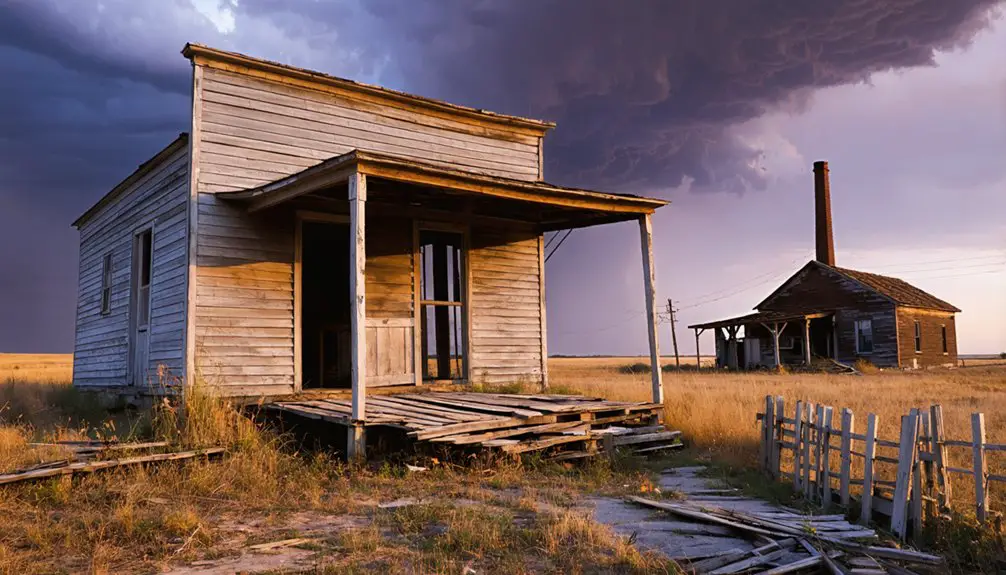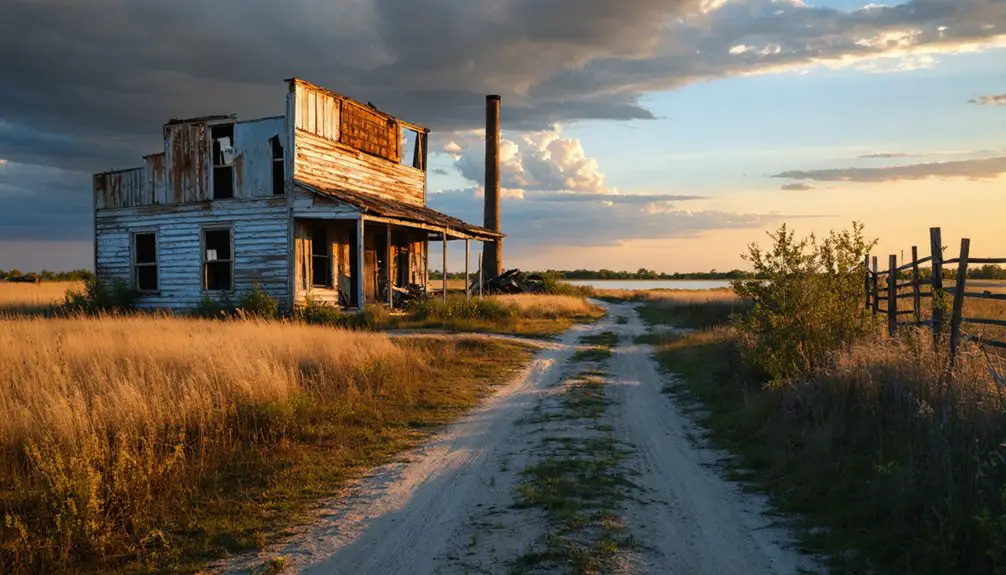You’ll find Lake Creek nestled in Greer County, Oklahoma, where homesteaders first settled in 1898. This once-thriving mining community reached its peak in the 1920s with 248 active mills processing lead and zinc deposits. The town’s historic remnants include a consolidated stone schoolhouse, pioneer monument, and Baptist church with parsonage. Though isolated from major railways, Lake Creek’s preserved structures and mysterious cemetery hold fascinating tales of Oklahoma’s frontier past.
Key Takeaways
- Lake Creek began as a mining town in southwestern Oklahoma around 1898, flourishing during the lead and zinc mining boom of the 1920s.
- The town’s decline was largely due to its isolation from major railroads and highways, limiting transportation and economic growth.
- Historic structures include a 1920s stone schoolhouse, Baptist church, trading post, and pioneer monument commemorating early settlers.
- An abandoned cemetery near Brown Springs Road contains mostly unmarked graves from the 1800s, surrounded by dense woods.
- Visitors must plan carefully as the site requires foot travel through overgrown areas, and GPS may be unreliable.
Early Settlement and Community Formation
While harsh conditions tested the resolve of early settlers, Lake Creek’s establishment began in earnest around 1898 as homesteaders claimed and cultivated the available land.
Similar to Range Valley Farm, the settlement’s placement near waterways provided vital resources for agriculture and daily life. These pioneers faced formidable challenges that required tremendous strength and determination to overcome, yet their community resilience helped them persevere and establish thriving farmsteads across the region. Like many Oklahoma ghost towns, Lake Creek’s origins were tied to natural resource discoveries and development.
As families put down roots, they built the foundations of a close-knit farming community. Their legacy lives on through a commemorative monument that honors their pioneer struggles and achievements.
You’ll find that these early homesteaders didn’t just survive – they created a sustainable agricultural settlement that would support multiple generations through the establishment of schools, churches, and essential services that formed Lake Creek’s core identity.
Geographic Location and Natural Features
The resilient farming community of Lake Creek took root in southwestern Oklahoma’s Greer County, where rolling prairies stretch toward the Oklahoma-Kansas border.
You’ll find this ghost town’s fertile agricultural lands about 13 miles south of the Kansas state line, where topographic features consist mainly of gently sloping terrain suited for cultivation and grazing. Historical topographic maps since 1955 have documented the area’s evolving landscape. The area was originally inhabited by Plains tribes including the Kiowa and Apache before European settlement.
Despite its name’s hydrological significance, Lake Creek doesn’t have major water bodies nearby, though seasonal creeks and springs once sustained the area’s determined homesteaders.
Here’s what shaped this freedom-loving community’s landscape:
- Continental climate with hot, dry summers and occasional winter snows
- Native prairie grasslands with scattered trees along waterways
- Rich soil perfect for dryland farming practices
- Natural drainage patterns that supported early agricultural settlement
Economic Rise and Peak Years
Contrary to its agricultural surroundings, Lake Creek’s explosive growth stemmed from rich lead and zinc deposits discovered in the early 1900s.
You’d have witnessed mining productivity reach staggering levels by the 1920s, with thousands of workers extracting millions in ore value annually. The district became one of the nation’s leading producers, establishing remarkable economic sustainability through its peak years.
The boom transformed Lake Creek into a bustling hub where you’d find thriving commercial ventures like saloons, supply shops, and assay offices. The region’s mining operations expanded rapidly to include 248 active mills by 1927.
Mills and processing plants dotted the landscape while churches, schools, and worker housing sprang up to serve the growing population. Like many thriving towns, Lake Creek faced potential economic busts that threatened its long-term survival.
Despite hazardous conditions and modest wages, miners built a tight-knit community centered on shared prosperity and mutual support.
Transportation Network Changes
Since its earliest days, Lake Creek’s development was shaped by primitive transportation routes like the Osage Trace and Black Dog Trail, which Native Americans had established for hunting and trade across Oklahoma.
Native American trade routes carved Lake Creek’s early pathways, laying down vital corridors that would shape the town’s destiny.
The transportation evolution around Lake Creek reveals how shifting networks influenced the town’s fate. The town’s location away from the MK&T Railway line, which laid the first tracks in Indian Territory in 1870, contributed to its isolation. Much like Cloud Chief’s experience with irregular freight service, Lake Creek struggled to maintain reliable supply lines.
- You’ll find that Lake Creek’s early rural accessibility depended on horse-drawn wagons and stagecoaches, with the Texas Road (now U.S. Highway 69) serving as an essential north-south route.
- The town’s growth was stunted by the absence of railroad connections, while nearby communities with rail service flourished.
- By the 1940s, you could find basic transport services like a gas station and garage, but roads remained limited to two-wheel drive.
- The bypass of major highways eventually sealed Lake Creek’s decline, as traffic and commerce shifted elsewhere.
Cultural Heritage and Social Life
Located at the heart of Lake Creek’s social fabric, the consolidated stone and brick schoolhouse built in 1920 anchored community life until its closure in 1957.
A bustling general store and gas station provided essential services to the community during the 1940s.
You’d find the community’s spirit thriving through cultural events at multiple churches, which served both as places of worship and social hubs. The Baptist church and Church of Christ hosted regular community gatherings, while the general store provided a casual meeting spot for daily interactions.
You can still trace Lake Creek’s pioneering heritage through the schoolyard monument honoring early settlers’ endurance. Similar to how the Five Civilized Tribes once held important council meetings in the region, Lake Creek residents gathered regularly to discuss community matters.
Though many residents relocated when their children transferred to Granite schools in 1957, Lake Creek’s cultural legacy lives on through preserved farmhouses, churches, and cemeteries that were carefully relocated before reservoir construction, ensuring the community’s memory endures.
Factors Leading to Abandonment
The decline of Lake Creek unfolded through multiple interconnected factors in the early 20th century. The community’s dynamics shifted dramatically as economic hardships and limited industrial development took their toll.
Economic decline and stagnant growth steadily eroded Lake Creek’s vitality during the early 1900s, transforming the once-vibrant community.
You’ll find that population shifts accelerated when the Katy Railroad bypassed the area, choosing instead to establish a depot in Eufaula.
- Agricultural challenges and the absence of valuable mineral resources like lead or zinc prevented the town from experiencing sustained economic growth.
- Transportation isolation occurred when major railroads bypassed Lake Creek, severely limiting trade opportunities.
- Rural-to-urban migration drew younger residents away to larger cities with better job prospects.
- School consolidation in 1919 reflected the dwindling population and centralization of community services.
Notable Structures and Landmarks

You won’t find any historic trade posts, cemeteries, or railroad infrastructure among Lake Creek’s surviving landmarks, as these features were never part of the original settlement.
The community’s notable structures were primarily centered around its school, churches, and commercial buildings near the main intersection.
While most of these buildings have now vanished, you can still visit the pioneer monument at the old school site and see the Baptist church with its parsonage, which stand as rare surviving structures from Lake Creek’s more vibrant past.
Historic Trade Post Remains
Standing as a memorial to frontier commerce, Lake Creek’s historic trading post featured a prominent two-story structure measuring 25 by 100 feet that served as both merchant space and community hub.
The trading post’s architecture reflected its essential role in the region’s development, strategically positioned along supply routes between Dodge City and Fort Elliott.
Key features of the historic site include:
- A general store on the ground floor with living quarters above
- A nearby sawmill that produced walnut lumber for construction
- Water-powered flour mills enhanced by a millrace drop and dam
- Foundation remains and posts that hint at picket-post construction methods
You’ll find these remnants near Lake Creek, where the post once served as a significant waypoint for stagecoaches, mail services, and supply wagons during the late 19th century.
Cemetery and Burial Grounds
High atop a secluded hill near Brown Springs Road lies an abandoned cemetery dating back to the 1800s, roughly a mile from the Chickasaw Smoke Shop.
Dense woods and cedars now shroud the mostly unmarked graves, while a natural lagoon formed by Brown Springs sits nearby – once used as a notorious body dumping ground.
You’ll find headstones of both outlaws and local residents scattered throughout the grounds, including one marker updated in the 1970s commemorating a young woman who died at age 20.
The site’s dark history includes secret gatherings and reported ghost sightings, with visitors claiming to hear unexplained voices calling out names.
Local burial practices of the territorial era are evidenced by the cemetery’s layout, though many graves remain undocumented due to deterioration and overgrowth.
Abandoned Railroad Infrastructure
Three major railroad lines once crisscrossed through Lake Creek, connecting the town to regional hubs like Enid and Arkansas City.
These historic railroad routes served as crucial arteries for transporting agricultural goods and coal from the Lehigh mines.
Today, you’ll find scattered remnants of this once-bustling rail network throughout the area.
Here’s what remains of Lake Creek’s railroad infrastructure:
- Old railroad bed foundations visible in wooded areas near former town sites
- Abandoned bridge piers and deteriorating culverts along previous track alignments
- Partial embankments and signal post remains that outline original route paths
- Overgrown spurs and wyes once used for turning trains
The historical significance of these railroad ruins provides tangible evidence of Lake Creek’s former importance as a transportation hub in early Oklahoma.
Historical Maps and Documentation

Through extensive cartographic records and archival collections, Lake Creek’s layout and development can be traced in remarkable detail on historical Oklahoma maps from the late 19th and early 20th centuries.
You’ll find intricate depictions of the town’s infrastructure, including schools, churches, public parks, and residential areas that once defined this Creek County community.
The historical maps reveal how Lake Creek connected to essential transportation routes and show the careful planning of its streets and public spaces.
These archival documents, housed at institutions like the University of Oklahoma’s library, help you understand the town’s eventual decline, particularly as railroad routes shifted and reservoir construction reshaped the region.
The maps also highlight land use patterns, property boundaries, and the locations of significant cultural landmarks like cemeteries and religious institutions.
Modern-Day Exploration and Access
While Lake Creek’s ghostly remnants beckon history enthusiasts, accessing the site requires careful planning and respect for local restrictions. Current access often involves traversing rural roads and potentially seeking landowner permission before exploring. You’ll need to prepare for remote conditions with limited facilities nearby.
- Check updated maps and local historical societies for accurate directions, as GPS systems mightn’t reflect the changed landscape.
- Be prepared to explore on foot, as many original streets are now overgrown or impassable.
- Document your visit through photos rather than artifact collection, as removal is prohibited.
- Visit during dry seasons for better accessibility, and always respect posted warnings or barriers.
The site primarily features scattered foundations and debris amid reclaimed nature, offering a quiet, isolated atmosphere that’s typical of Oklahoma’s forgotten boomtowns.
Legacy in Oklahoma’s Ghost Town History
Lake Creek’s evolution from a thriving rural community to a ghost town mirrors the fate of countless Oklahoma settlements that emerged during the homesteading era of 1898.
You’ll find its story particularly compelling, as it showcases pioneer resilience through the establishment of essential services like the general store, cotton gin, and churches that once served the farming community.
The consolidation of Lake Creek School with Granite in 1957 marked a pivotal shift in the area’s decline, reflecting broader patterns of rural depopulation across Oklahoma.
Today, while most structures have vanished, the Baptist church, parsonage, and commemorative monument stand as symbols of the community‘s rural heritage.
These remnants help preserve Lake Creek’s place in Oklahoma’s cultural transformation from scattered homesteads to centralized towns.
Frequently Asked Questions
Are There Any Reported Paranormal Activities or Ghost Sightings in Lake Creek?
You won’t find documented ghost encounters or spectral legends in the records. While Oklahoma’s ghost towns often have paranormal tales, there’s no confirmed evidence of supernatural activity here.
What Wildlife Species Now Inhabit the Abandoned Town Site?
You’ll find white-tailed deer, coyotes, raccoons, and various birds making wildlife observations easy in Lake Creek’s abandoned habitats. Owls roost in old structures while hawks hunt the surrounding meadows.
Can Metal Detecting Be Legally Conducted at Lake Creek?
Want to stay legal while treasure hunting? You’ll need to verify land ownership and get proper permissions first. Metal detecting laws require landowner consent, and you must avoid any protected archaeological areas.
Were Any Movies or Television Shows Ever Filmed at Lake Creek?
You won’t find any documented film history or official production locations at this site. Available records and regional sources don’t show any movies or TV shows being filmed there.
Do Any Former Residents or Their Descendants Still Visit Regularly?
You’ll find few documented cases of regular visits by former residents, though descendant gatherings occasionally happen during anniversaries or family reunions. Most visits are sporadic rather than routine.
References
- https://en.wikipedia.org/wiki/List_of_ghost_towns_in_Oklahoma
- https://www.okhistory.org/publications/enc/entry?entry=GH002
- https://www.lakeeufaula.com/news–travel–Is-There-A-Ghost-Town-Under-Lake-Eufaula/7265
- https://pastmaps.com/explore/us/oklahoma/greer-county/lake-creek/hiking-exploration
- https://freepages.rootsweb.com/~gtusa/history/usa/ok.htm
- https://www.youtube.com/watch?v=1stZe7ukjts
- https://kids.kiddle.co/List_of_ghost_towns_in_Oklahoma
- https://www.ghosttowns.com/states/ok/lakecreek.html
- https://jrap.scholasticahq.com/api/v1/articles/9543-the-economics-of-ghost-towns.pdf
- https://www.youtube.com/watch?v=xg8SpCG-wDg



